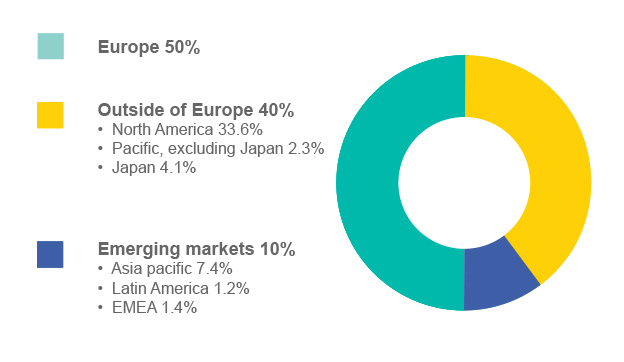5 ways to spread your risk

As a novice investor, it is good to develop your own investment strategy. An important part of this is risk diversification. This helps to smooth out the fluctuations in the value of your investments. With proper diversification, the highs and lows are less extreme. Here, we outline 5 ways to diversify your investments.
Investing involves risks. You could lose (some of) the money you invested.
Diversify across investment categories
You can spread risk in your portfolio by including investment categories that react differently to specific events. You can utilize our entire range: shares, ETFs, equity funds, bond funds, or mixed funds. This makes you less vulnerable to sharp declines in share prices or interest rate changes on bonds.
To achieve effective diversification with Self-directed Investing Basic, investment funds and/or ETFs are necessary, enabling you to invest in bonds and regions worldwide. These funds and ETFs always invest in multiple shares or bonds, thereby enhancing diversification.
The distribution of shares, bonds, and other products in your portfolio depends on the level of risk you wish to take. For a low-risk approach, you might choose a defensive portfolio with a composition of 20% shares, 70% bonds and 10% cash. Conversely, a highly offensive portfolio consists of 90% shares, 0% bonds and 10% cash.
Diversify across regions
Purchase investments from various countries and continents to mitigate risk if one country or region faces challenges. If you only buy AEX shares for instance, your investments are susceptible to downturns in the AEX. We provide guidance on the distribution recommended by ABN AMRO experts.
This is ABN AMRO's strategic distribution:

Diversify across themes and sectors
Long-term developments such as ageing populations, energy transitions, and digitalisation present societal challenges requiring innovative solutions. Incorporating themes into your portfolio allows you to capitalise on these societal and economic changes. Besides cross-sector themes, you can also focus on specific sectors. However, it's advisable to invest in various business sectors to avoid vulnerability during downturns in a particular sector, such as IT.
There are funds and ETFs that invest in specific sectors or themes. Use the Fund Selector to find these investment funds and see what the fund invests in.
Diversify across buying moments
Purchase investments at different times within one or more years to achieve an average purchase price through multiple acquisition prices. This can be done through periodic investing.
Diversify over time
Be patient with your investments and invest your money over a longer period. Investing for the long term with patience increases the likelihood of positive returns.
Investing involves risks
Investing involves risks. You could lose (some of) the money you invested. If you are going to invest, it is important that you are aware of this. Invest with money you can spare. Read more about the risks associated with investments.
